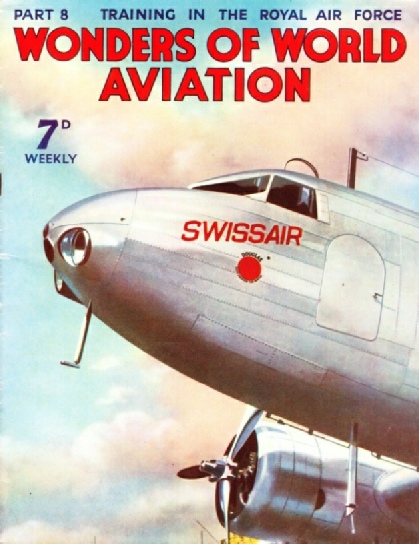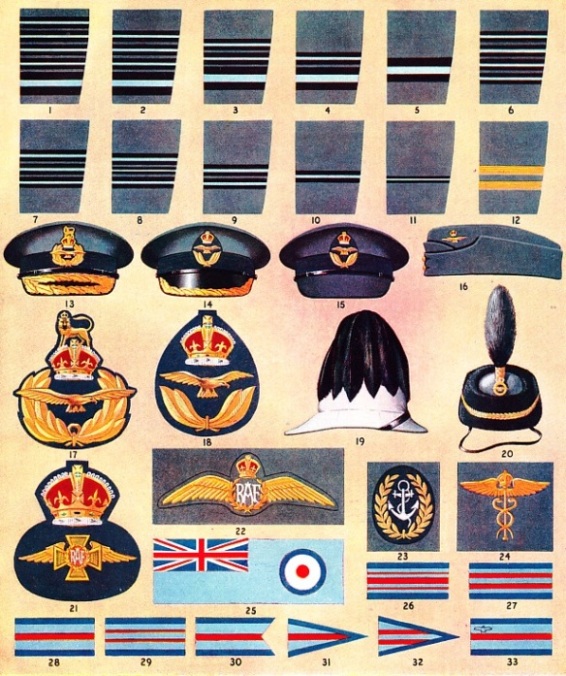
© Wonders of World Aviation 2015-


Part 8
Part 8 of Wonders of World Aviation was published on Tuesday 26th April 1938, price 7d.
This part included a colour plate showing ranks, badges and flags of RAF officers. This formed part of the article on Training RAF Pilots.
The Cover
Our cover photograph this week shows the nose of one of the Swissair liners. It is an American Douglas machine. Powerful lights are fixed in the nose of the machine to assist the pilot when he is making landings at night.
This illustration later appeared as the colour plate with Part 23.

Contents of Part 8
The Designer of the Avro (Part 2)
The story of Sir Alliott Verdon-Roe , whose biplane of 1908 was followed by many famous designs. This chapter is concluded from part 7.
It is the fourth article in the series on Makers of Air History.
Percival Aircraft Types
Few aeroplanes have had so marked an influence upon the type of machine generally adopted and flown by private owners as the Percival Gull. This and other designs by Captain Percival are described in this chapter.
Dramas of Air Rescues
Many lives have been saved and much suffering has been alleviated by the use of air transport. Success in emergency rescue work demands great skill, initiative and resource on the part of the pilots concerned. This chapter describes aid by aeroplane for stranded travellers, isolated communities and patients requiring medical treatment.
Across the Pacific
The famous “Clipper” flying boat service from California, USA, to the Philippine Islands. Advance in aeronautics at times is rapid, and now we have Pan American Airways running a regular service of flying boats from the west coast of the United States to Manila, capital of the Philippine Islands, a distance of over eight thousand miles; from Manila to Hong Kong the journey may be continued in one of the Sikorsky machines. This development of transpacific travel is one of extraordinary interest, as you will find in this chapter.
This is the second article in the series Air Routes of the World.
Training RAF Pilots
The tuition of pupils from the time of joining the service until they reach their squadrons. One year is about the time it takes to train an RAF pilot to the standard at which he is ready to join a squadron. During this time he will carry out between 150 and 200 hours’ flying, nearly 100 hours of which will be solo flying.
Ranks, Badges and Flags of the RAF (Officers)
Key to the colour plate below:
1. Marshal of the RAF; 2. Air Chief Marshal; 3. Air Marshal; 4. Air Vice-Marshal; 5. Air Commodore; 6. Group Captain; 7. Wing Commander; 8. Squadron leader; 9. Flight Lieutenant; 10. Flying Officer; 11. Pilot Officer; 12. Flight Lieutenant Full Dress (other officer ranks similar for full dress); 13. Officers of Air Rank; 14. Group Captain; 15. All other officers (for walking out and ceremonial); 16. Forage or Field Service Cap; 17. Officers of Air rank; 18. Officers below Air Rank; 19. Full Dress Tropical Hat (worn by Air Officers Commanding - serving abroad); 20. Full Dress Hat (all ranks); 21. Chaplain’s Cap badge; 22. Pilot’s Badge; 23. Fleet Air Arm badge (worn on sleeve above ranking stripes); 24. Medical Officer’s Collar Badge; 25. RAF Ensign; 26. Marshal of the RAF; 27. Air Chief Marshal; 29. Air Vice-Marshal; 30. Air Commodore; 31. Group captain; 32. Wing Commander; 33. Squadron Leader.
Note - Although the Fleet Air Arm has been taken over by the Admiralty flying personnel will continue to be drawn from the Royal Air Force for a time, and this badge is still being worn.
Flight of the “Eagle” (Part 1)
The first serious attempt to fly to the North Pole, by Salomon Andrée. His name cannot be omitted from those pioneers of Polar exploration by air. Andrée’s flight was not a success; tragedy overtook him before its completion. But the attempt was of particular interest because, although the attempt took place in the 1890s, the story was destined not to be completed until 1930. This chapter is concluded in part 9.
